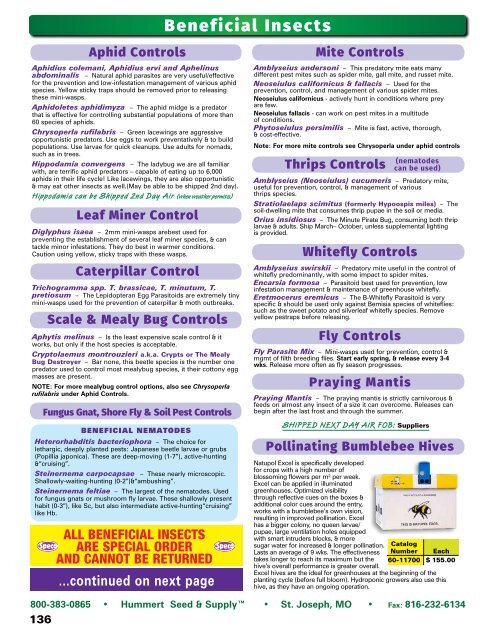2018 Seed Catalog
- No tags were found...
You also want an ePaper? Increase the reach of your titles
YUMPU automatically turns print PDFs into web optimized ePapers that Google loves.
Beneficial Insects<br />
Aphid Controls<br />
Aphidius colemani, Aphidius ervi and Aphelinus<br />
abdominalis – Natural aphid parasites are very useful/effective<br />
for the prevention and low-infestation management of various aphid<br />
species. Yellow sticky traps should be removed prior to releasing<br />
these mini-wasps.<br />
Aphidoletes aphidimyza – The aphid midge is a predator<br />
that is effective for controlling substantial populations of more than<br />
60 species of aphids.<br />
Chrysoperla rufilabris – Green lacewings are aggressive<br />
opportunistic predators. Use eggs to work preventatively & to build<br />
populations. Use larvae for quick cleanups. Use adults for nomads,<br />
such as in trees.<br />
Hippodamia convergens – The ladybug we are all familiar<br />
with, are terrific aphid predators – capable of eating up to 6,000<br />
aphids in their life cycle! Like lacewings, they are also opportunistic<br />
& may eat other insects as well.(May be able to be shipped 2nd day).<br />
Hippodamia can be Shipped 2nd Day Air (when weather permits)<br />
Leaf Miner Control<br />
Diglyphus isaea – 2mm mini-wasps arebest used for<br />
preventing the establishment of several leaf miner species, & can<br />
tackle minor infestations. They do best in warmer conditions.<br />
Caution using yellow, sticky traps with these wasps.<br />
Caterpillar Control<br />
Trichogramma spp. T. brassicae, T. minutum, T.<br />
pretiosum – The Lepidopteran Egg Parasitoids are extremely tiny<br />
mini-wasps used for the prevention of caterpillar & moth outbreaks.<br />
Scale & Mealy Bug Controls<br />
Aphytis melinus – Is the least expensive scale control & it<br />
works, but only if the host species is acceptable.<br />
Cryptolaemus montrouzieri a.k.a. Crypts or The Mealy<br />
Bug Destroyer – Bar none, this beetle species is the number one<br />
predator used to control most mealybug species, it their cottony egg<br />
masses are present.<br />
NOTE: For more mealybug control options, also see Chrysoperla<br />
rufilabris under Aphid Controls.<br />
Fungus Gnat, Shore Fly & Soil Pest Controls<br />
BENEFICIAL NEMATODES<br />
Heterorhabditis bacteriophora – The choice for<br />
lethargic, deeply planted pests: Japanese beetle larvae or grubs<br />
(Popillia japonica). These are deep-moving (1-7”), active-hunting<br />
&“cruising”.<br />
Steinernema carpocapsae – These nearly microscopic.<br />
Shallowly-waiting-hunting (0-2”)&“ambushing”.<br />
Steinernema feltiae – The largest of the nematodes. Used<br />
for fungus gnats or mushroom fly larvae. These shallowly present<br />
habit (0-3”), like Sc, but also intermediate active-hunting“cruising”<br />
like Hb.<br />
ALL BENEFICIAL INSECTS<br />
ARE SPECIAL ORDER<br />
AND CANNOT BE RETURNED<br />
...continued on next page<br />
Mite Controls<br />
Amblyseius andersoni – This predatory mite eats many<br />
different pest mites such as spider mite, gall mite, and russet mite.<br />
Neoseiulus californicus & fallacis – Used for the<br />
prevention, control, and management of various spider mites.<br />
Neoseiulus californicus - actively hunt in conditions where prey<br />
are few.<br />
Neoseiulus fallacis - can work on pest mites in a multitude<br />
of conditions.<br />
Phytoseiulus persimilis – Mite is fast, active, thorough,<br />
& cost-effective.<br />
Note: For more mite controls see Chrysoperla under aphid controls<br />
Thrips Controls<br />
(nematodes<br />
can be used)<br />
Amblyseius (Neoseiulus) cucumeris – Predatory mite,<br />
useful for prevention, control, & management of various<br />
thrips species.<br />
Stratiolaelaps scimitus (formerly Hypoospis miles) – The<br />
soil-dwelling mite that consumes thrip pupae in the soil or media.<br />
Orius insidiosus – The Minute Pirate Bug, consuming both thrip<br />
larvae & adults. Ship March– October, unless supplemental lighting<br />
is provided.<br />
Whitefly Controls<br />
Amblyseius swirskii – Predatory mite useful in the control of<br />
whitefly predominantly, with some impact to spider mites.<br />
Encarsia formosa – Parasitoid best used for prevention, low<br />
infestation management & maintenance of greenhouse whitefly.<br />
Eretmocerus eremicus – The B-Whitefly Parasitoid is very<br />
specific & should be used only against Bemisia species of whiteflies:<br />
such as the sweet potato and silverleaf whitefly species. Remove<br />
yellow pestraps before releasing.<br />
Fly Controls<br />
Fly Parasite Mix – Mini-wasps used for prevention, control &<br />
mgmt of filth breeding flies. Start early spring, & release every 3-4<br />
wks. Release more often as fly season progresses.<br />
Praying Mantis<br />
Praying Mantis – The praying mantis is strictly carnivorous &<br />
feeds on almost any insect of a size it can overcome. Releases can<br />
begin after the last frost and through the summer.<br />
SHIPPED NEXT DAY AIR FOB: Suppliers<br />
Pollinating Bumblebee Hives<br />
Natupol Excel is specifically developed<br />
for crops with a high number of<br />
blossoming flowers per m² per week.<br />
Excel can be applied in illuminated<br />
greenhouses. Optimized visibility<br />
through reflective cues on the boxes &<br />
additional color cues around the entry,<br />
works with a bumblebee’s own vision,<br />
resulting in improved pollination. Excel<br />
has a bigger colony, no queen larvae/<br />
pupae, large ventilation holes equipped<br />
with smart intruders blocks, & more<br />
sugar water for increased & longer pollination. <strong>Catalog</strong><br />
Lasts an average of 9 wks. The effectiveness Number Each<br />
takes longer to reach its maximum but the 60-11700 $ 155.00<br />
hive’s overall performance is greater overall.<br />
Excel hives are the ideal for greenhouses at the beginning of the<br />
planting cycle (before full bloom). Hydroponic growers also use this<br />
hive, as they have an ongoing operation.<br />
800-383-0865 • Hummert <strong>Seed</strong> & Supply • St. Joseph, MO • Fax: 816-232-6134<br />
136


